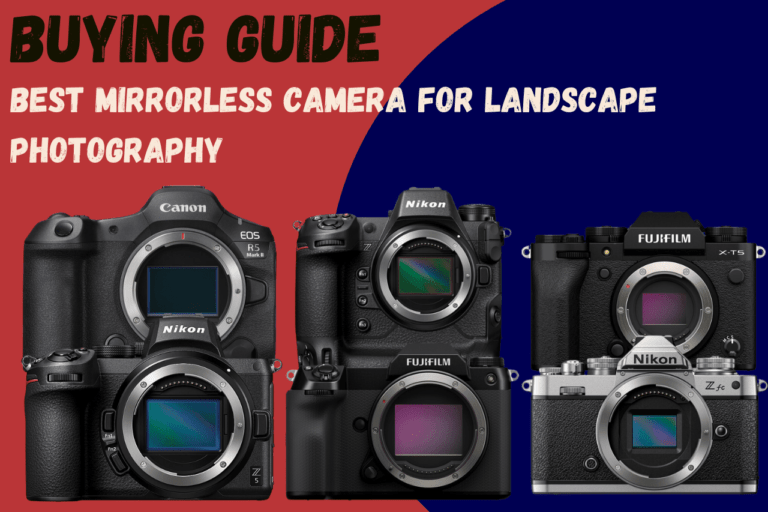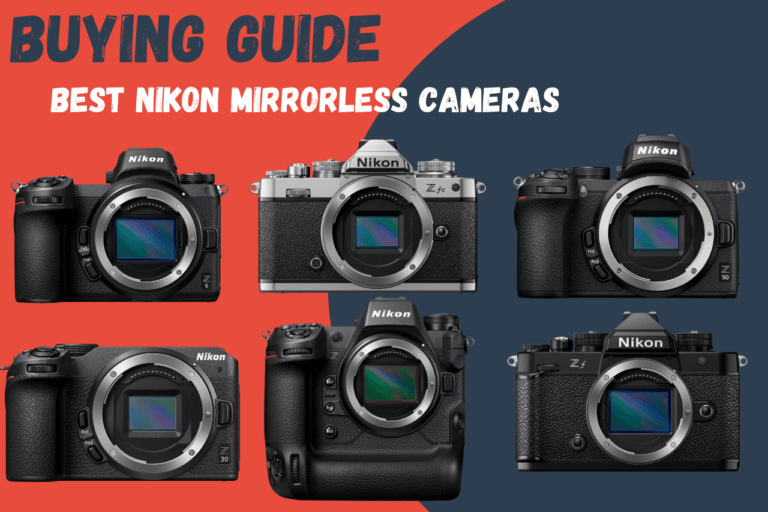If you’re like me—a passionate photographer constantly seeking to capture life’s decisive moments—Canon’s mirrorless lineup is an absolute game‑changer!
With Canon pouring innovation into its EOS R system, 2025 is set to be an exciting year for mirrorless enthusiasts. Btw, did you know that Canon’s latest models offer up to 8K RAW video recording and groundbreaking autofocus technology?

Whether you’re into fast‑paced sports photography or serene landscapes, this guide will walk you through everything you need to know about the best Canon mirrorless cameras available this year.
Let’s dive into a world where speed meets clarity and every shot becomes a masterpiece!

The Best Canon Mirrorless Cameras: Our Top Picks

The ratings next to each camera are based on extensive research and comparison with the help of sites like Versus and Camera Decision.
However, while they help order these cameras, they don’t reflect everything.
The “best camera” will primarily depend on your budget, the style of photography (or videography) you will need it for, and, of course, your skills to get the most out of it.
So please remember that these numbers are for illustration purposes only.

The prices are for the body only.
- Canon EOS R1 (94 points) [$6,299] – 2024
- Canon EOS R5 Mark II (93 points) [$4,299] – 2024
- Canon EOS R3 (92 points) [$4,499] – 2021
- Canon EOS R5 (88 points) [$2,999] – 2020
- Canon EOS R6 Mark II (84 points) [$1,999] – 2022
- Canon EOS R8 (82 points) [$1,299] – 2023
- Canon EOS R7 (79 points) [$1,399] – 2022
- Canon EOS R (74 points) [$1,499] – 2018
- Canon EOS RP (68 points) [$899] – 2019
- Canon EOS R50 (66 points) [$629] – 2023
- Canon EOS R10 (64 points) [$879] – 2023
- Canon EOS R100 (56 points) [$479] – 2023
Canon EOS R5 Mark II (Best Overall)
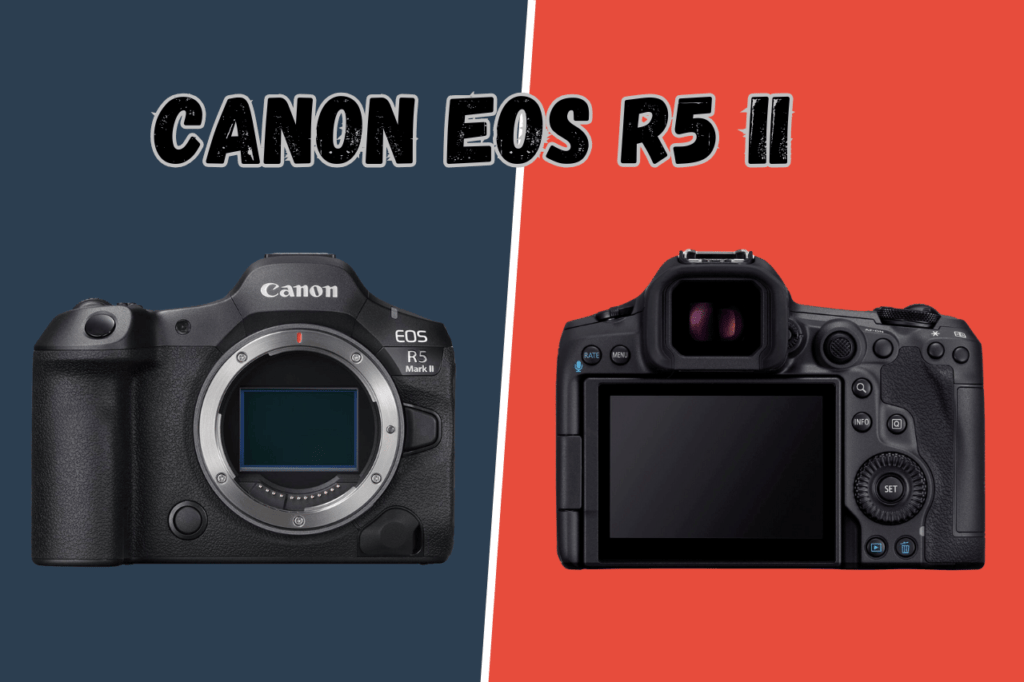
You might say that the Canon R1 has the highest score, which means it has better features (and that’s true). HOWEVER, when we dig a little deeper, there are extra features in the R5 Mark II that you cannot find in the R1 (especially for videographers), and for $2000 less. So, that’s why.
Camera Specifications
- Sensor: 45 MP full-frame, stacked backside‑illuminated CMOS sensor
- Megapixels: Approximately 45 MP (8192 x 5464 resolution)
- Lens: Canon RF mount (compatible with RF lenses; can use EF/EF‑S lenses with an adapter)
- LCD: 3.2‑inch fully articulated touchscreen (2.1 million dots)
- Viewfinder: 0.5‑inch OLED electronic viewfinder (5.76 million dots, 120 fps refresh)
- Max Continuous Shooting: 12 fps (mechanical shutter), up to 30 fps (electronic shutter)
- Max Video Resolution: 8K RAW video up to 60 fps; also supports 4K up to 120 fps
- Targeted Audience: Professional photographers and videographers
The Canon EOS R5 Mark II is a hybrid camera designed for professionals who need great still and video performance. With its 45-megapixel full‑frame stacked sensor, and the new DIGIC Accelerator technology, this camera delivers faster readout speeds, reduced rolling shutter, and excellent low‑light performance.
Also, its advanced Dual Pixel CMOS AF system—including eye‑controlled autofocus—ensures rapid and accurate focus even in challenging conditions, making it ideal for fast‑paced sports and wildlife photography.
Plus, it has robust 8K video capabilities that can go up to 60p (while the R1 only goes up to 6K 60p), which allows for detailed RAW recording, and the fully articulated touchscreen and high‑resolution EVF provide excellent framing and clarity.
For the body, the R5 Mark II is designed for extended shooting sessions because it has a solid, weather‑sealed body, though its weight might be a factor for those needing a lighter setup.
Price-wise, it’s a significant investment, but many users agree that the cutting‑edge features justify the cost for those who demand the best.
✔️What I Like:
- A sharp sensor that will make you wonder how you lived without it
- Autofocus that actually focuses on what you want (novel idea, right?)
- 8K video – because 4K wasn’t quite enough
- Tough build with weather sealing – take it anywhere, even into the apocalypse
- EVF so good, you’ll forget what a normal viewfinder looks like
❌What I Don’t Like:
- Wallet-crushing price – hope you’re sitting down
- Overheats during long 8K shoots – because why not add stress to your life?
- Heavy enough to double as a dumbbell
- Doesn’t play nice with some third-party batteries
Canon EOS R1

Camera Specifications
- Sensor: 24.2 MP full‑frame, stacked backside‑illuminated CMOS sensor
- Megapixels: 24.2 MP (6000 x 4000 resolution)
- Lens: Canon RF mount (compatible with RF lenses; EF/EF‑S lenses via adapter)
- LCD: 3.2‑inch fully articulated touchscreen (2.1 million dots)
- Viewfinder: 9.44‑million dot OLED electronic viewfinder with 0.9x magnification and 100% coverage
- Max Continuous Shooting: Up to 40 fps (electronic shutter) and 12 fps (mechanical shutter)
- Max Video Resolution: Up to 6K 60p RAW internal recording
- Targeted Audience: Professional photojournalists and sports photographers
The Canon EOS R1 marks Canon’s debut flagship in the EOS R system. It combines a state‑of‑the‑art 24.2 MP full‑frame stacked sensor with the new DIGIC Accelerator technology (in tandem with the DIGIC X processor) to offer exceptionally fast readout speeds and minimal rolling shutter, which is key for capturing fast action.
In addition, this camera has an advanced autofocus system, including eye‑controlled focus and refined subject tracking, which makes it especially appealing for professionals who need to nail fleeting moments in sports and news events.
If we talk about real‑world feedback, a lot of professional photographers praised the R1 for its reliability under challenging conditions. Plus, the high‑speed continuous shooting of up to 40 fps ensures that every critical moment is captured, while the robust build and weather‑sealed design add to its appeal on the field.
However, the premium price of $6,299 and a relatively heavier body may be a consideration for those who need a more compact setup or are working within tighter budgets.
✔️What I Like:
- Autofocus with eye-tracking – because who doesn’t want to look sharp?
- Continuous shooting speed that’ll leave your competition in the dust
- Built like a tank, but a weatherproof one
- Viewfinder so clear, you’ll think you’re seeing into the future
- EF-mount lens compatibility – old lenses, new tricks
❌What I Don’t Like:
- So many features, you might need a manual just to use it
- With that price, get ready to sell a kidney
- Big, bulky, and feels like lifting weights at the gym
- Dynamic range that’s just a little…meh
Canon EOS R3

Camera Specifications
- Sensor: 24 MP full‑frame stacked CMOS sensor
- Megapixels: 24 MP (approx. 6000 x 4000 resolution)
- Lens: Canon RF mount (compatible with Canon RF lenses; EF/EF‑S lenses via adapter)
- LCD: 3.2‑inch fully articulating touchscreen (approx. 2.1 million dots)
- Viewfinder: 0.5‑inch OLED electronic viewfinder with 5.76 million dots and blackout‑free performance
- Max Continuous Shooting: Up to 30 fps with electronic shutter; 12 fps with mechanical shutter
- Max Video Resolution: 6K RAW video up to 60p (with additional 4K options up to 120p)
- Targeted Audience: Professional sports photographers, photojournalists, and fast‑action shooters
The Canon EOS R3 is designed as a flagship model for professionals who need rapid performance without compromise. Its 24 MP full‑frame stacked sensor delivers excellent clarity and dynamic range while reducing rolling shutter artifacts—a critical benefit when capturing fast-moving subjects. The advanced Dual Pixel CMOS AF system, featuring eye‑tracking and near‑instant focus acquisition, makes it a top choice for sports and news photography.
I should highlight the R3’s ability to capture decisive moments with its impressive continuous shooting speed of up to 30 fps via the electronic shutter—ensuring a blackout‑free experience in the viewfinder.
The robust, weather‑sealed body is built to endure harsh conditions on the field, although its weight could be a problem for anyone using it for a long time handheld. Plus, the price point of around $4,499 is a lot, but it is well justified by the camera’s top‑end performance and professional features.
✔️What I Like:
- Blackout-free, high-res EVF – because you deserve to see everything
- 30 fps continuous shooting – blink and you’ll miss nothing
- Autofocus that tracks your subject like a hawk on a mission
- Low-light and action shots? No problem. It’s got this
- Tough as nails with weather-sealing – shoot in a storm, literally
❌What I Don’t Like:
- Price tag that could make you reconsider your life choices
- Heavier than your mirrorless camera – skip the gym today
- 24 MP is a little too much of a ‘just enough’ situation
Canon EOS R5
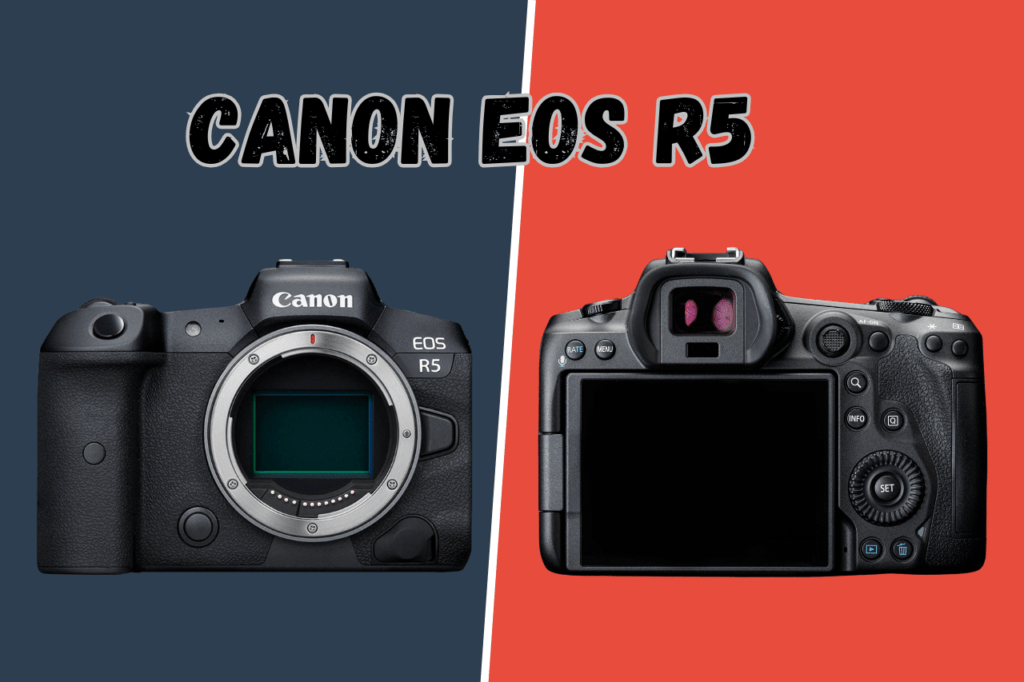
Camera Specifications
- Sensor: 45 MP full‑frame backside‑illuminated CMOS sensor
- Megapixels: Approximately 45 MP (8192 x 5464 resolution)
- Lens: Canon RF mount (compatible with RF lenses; also supports EF/EF‑S lenses via adapter)
- LCD: 3.2‑inch fully articulating touchscreen (approx. 2.1 million dots)
- Viewfinder: 0.5‑inch OLED electronic viewfinder (5.76 million dots, 100% coverage)
- Max Continuous Shooting: 12 fps (mechanical shutter) / 20 fps (electronic shutter)
- Max Video Resolution: 8K up to 30 fps; 4K up to 120 fps
- Targeted Audience: Professional photographers and videographers
The Canon EOS R5 is one of Canon’s flagship mirrorless cameras, engineered for professionals seeking an exceptional blend of high resolution and advanced performance. This camera has a 45 MP full‑frame sensor that delivers great detail and dynamic range, even in challenging lighting conditions.
Plus, the combination of the DIGIC X processor with advanced image‑processing algorithms ensures rapid readout speeds and excellent noise control, which makes it a great option for fast‑paced shooting scenarios like sports and wildlife photography.
Ergonomically, the R5 is designed with a well‑balanced and robust body that’s weather‑sealed for durability on the field (try reading this sentence with one breath).

In addition to all of this, the fully articulating touchscreen and high‑resolution EVF allow for precise framing and intuitive control over settings.
However, these high‑end features come at a very premium price, which makes it a choice for pros and to be avoided by beginners.
If we talk about real‑world use, this camera’s ability to shoot 8K video and capture stunning still images gives it its popularity, though some people have noted that extended 8K recording sessions can lead to overheating.
✔️What I Like:
- 45 MP sensor – detail so sharp, you’ll feel like you’re zooming in on a pixel
- Autofocus that tracks eyes and subjects like a pro detective
- 8K RAW video – because 4K is so last year
- Built to survive anything – weatherproof for the elements and your bad decisions
- Fully articulating touchscreen – for when you need to see everything upside down
❌What I Don’t Like:
- Price that might make you double-check your bank account
- Overheats during long 8K shoots – because who doesn’t want their camera to join the sauna?
- Heavy enough to make you regret your shoulder workout the next day
Canon EOS R6 Mark II

Camera Specifications
- Sensor: 24.2 MP full‑frame CMOS sensor
- Megapixels: Approximately 24.2 MP
- Lens: Canon RF mount (compatible with RF lenses and, via adapter, EF/EF‑S lenses)
- LCD: 3‑inch fully articulating touchscreen (around 1.62 million dots)
- Viewfinder: Electronic viewfinder with roughly 3.68 million dots and a 120 fps refresh rate
- Max Continuous Shooting: Up to 12 fps (mechanical shutter) and up to 40 fps (electronic shutter)
- Max Video Resolution: 4K up to 60 fps (oversampled from a 6K sensor readout)
- Targeted Audience: Professional sports and events photographers
The Canon EOS R6 Mark II is a highly versatile full‑frame mirrorless camera that has a great balance between speed and image quality. With its 24.2 MP sensor paired with the DIGIC X processor, the camera delivers rapid sensor readout and good low‑light performance.
Plus, with the advanced autofocus system, enhanced by new processing technology, this camera offers precise tracking—even for fast‑moving subjects—making it a superb choice for sports and event photography.
Real‑world reviews from various photographers consistently highlight its ability to capture moments with up to 40 fps using the electronic shutter, ensuring nearly blackout‑free viewfinder performance.
Ergonomically, the R6 Mark II shines with its comfortable grip and intuitive controls that allow for extended shooting sessions. Additionally, its 4K video capabilities (oversampled from a 6K sensor readout) produce excellent detail and clarity, catering well to hybrid shooters who want both stills and video.
For the downsides, while the camera’s 24.2 MP resolution is more than enough for many applications, some of you might wish for higher resolution for large‑format prints or heavy cropping. Moreover, managing the high‑speed shooting modes can require a brief period of adjustment.
✔️What I Like:
- Autofocus that will say good bye to your blurry nightmares
- 40 fps continuous shooting
- Low-light performance that’ll make you rethink your night vision goggles
- Tough, weather-sealed build with an ergonomic grip – for those who shoot like they’re climbing a mountain
❌What I Don’t Like:
- 24.2 MP resolution – because sometimes ‘just enough’ isn’t enough
- Electronic shutter modes might require a bit of a learning curve (welcome to photography school)
- Minor artifacts with the electronic shutter – like an occasional digital hiccup
- No 8K or 6K video – guess you’ll have to settle for just really great 4K
Canon EOS R8
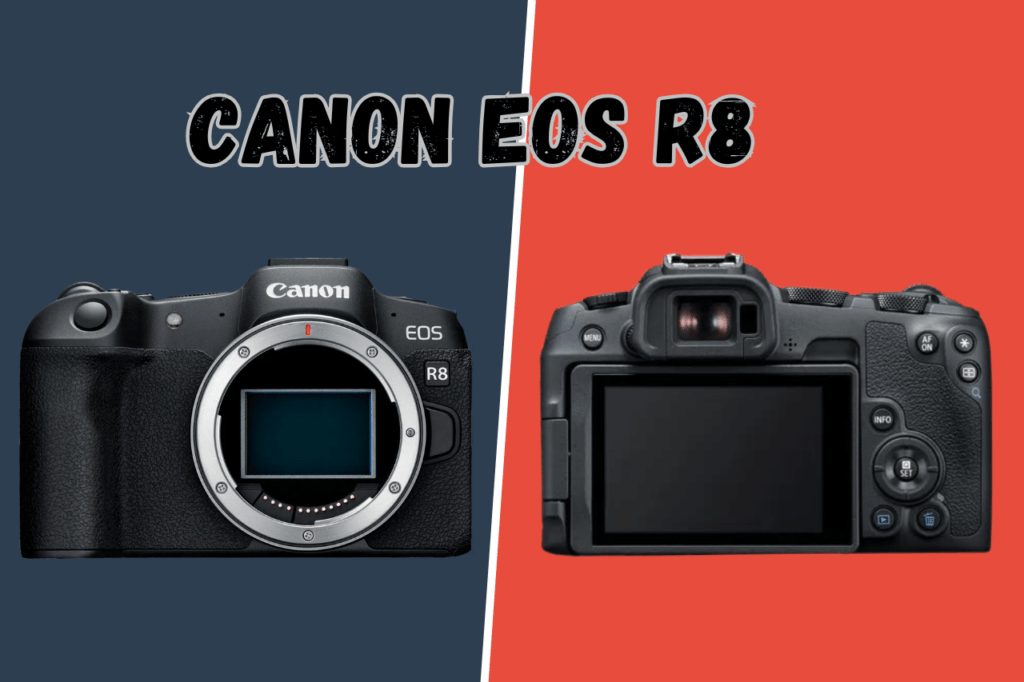
Camera Specifications
- Sensor: 24.2 MP Full‑Frame CMOS Sensor
- Megapixels: Approximately 24.2 MP
- Lens: Canon RF mount (compatible with Canon RF lenses; EF/EF‑S lenses via adapter)
- LCD: 3‑inch fully articulating touchscreen (approx. 1.62 million dots)
- Viewfinder: 2.36‑million dot electronic viewfinder
- Max Continuous Shooting: Up to 40 fps (electronic shutter)
- Max Video Resolution: 4K up to 60 fps (oversampled from 6K)
- Targeted Audience: Enthusiast photographers and entry‑level full‑frame users on a budget
The Canon EOS R8 is designed to deliver the essentials of a high‑end full‑frame mirrorless system in a more compact and affordable package. Its 24.2 MP sensor produces excellent detail and dynamic range, which makes it well‑suited for everyday photography, portraits, and landscapes. Despite its approachable price, the R8 offers fast electronic shutter speeds up to 40 fps, ensuring that even fleeting moments are captured with precision.
This camera has an intuitive control layout and comfortable ergonomics. The autofocus system, powered by Canon’s Dual Pixel CMOS AF technology, performs reliably in most shooting scenarios, though it may not match the speed of Canon’s flagship models. The camera’s 4K video capability, which benefits from oversampling from a 6K source, delivers crisp and detailed footage ideal for vloggers and hybrid shooters.
Overall, the EOS R8 offers a balanced blend of performance and ease of use. It’s a good choice for those stepping into the full‑frame world, without breaking the bank, while still enjoying many of the advanced features found in Canon’s higher‑tier cameras.
✔️What I Like:
- Compact and lightweight – full-frame power without the gym membership
- 40 fps continuous shooting – because slow is overrated
- 4K video oversampled for extra sharpness – who needs 6K anyway?
- Easy-to-use touchscreen and controls – no manual required (well, mostly)
- Great image quality without draining your bank account
❌What I Don’t Like:
- Viewfinder isn’t as sharp as the fancy models
- Autofocus is solid but won’t read your mind like flagship cameras
- Fewer customization options – take it or leave it
Canon EOS R7

Camera Specifications
- Sensor: 32.5 MP APS‑C CMOS sensor
- Megapixels: Approximately 32.5 MP
- Lens: Canon RF‑S mount (compatible with Canon RF‑S lenses; can use RF lenses via adapter)
- LCD: 3‑inch fully articulating touchscreen (around 1.62 million dots)
- Viewfinder: OLED electronic viewfinder with roughly 2.36 million dots
- Max Continuous Shooting: Up to 30 fps (electronic shutter) and 15 fps (mechanical shutter)
- Max Video Resolution: 4K up to 60 fps
- Targeted Audience: Sports and wildlife photographers
The Canon EOS R7 is a standout APS‑C mirrorless camera that leverages its 32.5 MP sensor to deliver detailed images and an effective focal length boost, thanks to its 1.6x crop factor. This makes it especially popular among sports and wildlife photographers who need that extra reach when shooting distant subjects. The camera’s advanced Dual Pixel CMOS AF system provides fast, accurate autofocus—even when tracking fast‑moving subjects—which ensures that you never miss those critical moments.
Another great thing about this camera is its rapid continuous shooting speed of up to 30 fps, which is ideal for capturing action in dynamic environments. Its robust build includes weather sealing, which makes it a reliable companion in challenging outdoor conditions.
Sure, the APS‑C sensor won’t match the full‑frame performance in low‑light situations, but the crop factor is a clear advantage for telephoto work. Overall, the R7 is a versatile camera that balances speed, image quality, and durability in a compact body.
✔️What I Like:
- 32.5 MP APS-C sensor – extra reach without the extra lens weight
- 30 fps burst shooting – blink and you’ll still catch the shot
- Dual Pixel AF that locks onto subjects like a heat-seeking missile
- Weather-sealed body – because the elements don’t care about your camera
- 4K video up to 60 fps – smooth, sharp, and ready for action
❌What I Don’t Like:
- APS-C sensor isn’t a low-light wizard like full-frame
- Compact body might not be ideal for marathon handheld sessions
- Not exactly a resolution powerhouse compared to flagship full-frame models
Canon EOS R

Camera Specifications
- Sensor: 30.3 MP full‑frame CMOS sensor
- Megapixels: Approximately 30.3 MP
- Lens: Canon RF mount (compatible with Canon RF lenses; EF/EF‑S lenses via adapter)
- LCD: 3‑inch fully articulating touchscreen (approximately 1.04 million dots)
- Viewfinder: 0.5‑inch OLED electronic viewfinder with 3.69 million dots, 0.9x magnification, 100% coverage
- Max Continuous Shooting: Up to 8 fps (electronic shutter) and around 5 fps (mechanical shutter)
- Max Video Resolution: 4K UHD up to 30p (with a significant crop)
- Targeted Audience: Enthusiast photographers and early full‑frame mirrorless adopters
The Canon EOS R was Canon’s first full‑frame mirrorless camera, launching in 2018 and paving the way for the EOS R system. This camera was packed with a 30.3 MP sensor that produces excellent image quality with good dynamic range and color reproduction.
With this camera came the introduction of the Canon RF mount. It was a major innovation that opened up a new range of lens designs, although the early lens lineup wasn’t as extensive as what later models enjoyed.
What do people say about this camera?
Well, while the EOS R delivers solid image quality and a refined build for its time, its autofocus system and lack of in‑body image stabilization (IBIS) can feel limiting compared to more recent Canon models like the EOS R5 Mark II or R6 Mark II.
Additionally, its 4K video recording suffers from a severe crop factor, which can restrict creative framing in video. But, despite these shortcomings, the EOS R remains a historically significant model that set the stage for Canon’s mirrorless evolution, and many users still appreciate its classic design and overall image quality.
✔️What I Like:
- 30.3 MP sensor – crisp images with beautiful colors
- RF mount – unlocking a new era of fancy glass
- Sharp EVF and a fully articulating touchscreen – frame it your way
❌What I Don’t Like:
- Autofocus isn’t the speed demon found in newer models
- No in-body stabilization – better keep those hands steady
- 4K video comes with a hefty crop – say goodbye to wide-angle magic
Canon EOS RP

Camera Specifications
- Sensor: 26.2 MP full‑frame CMOS sensor
- Megapixels: Approximately 26.2 MP
- Lens: Canon RF mount (supports EF/EF‑S lenses via adapter)
- LCD: 3‑inch fully articulating touchscreen (around 1.04 million dots)
- Viewfinder: 0.39‑inch OLED electronic viewfinder with roughly 2.36 million dots
- Max Continuous Shooting: Around 5 fps
- Max Video Resolution: 4K UHD at 24p (with a significant crop)
- Targeted Audience: Entry‑level full‑frame enthusiasts and hobbyists
The Canon EOS RP is Canon’s most affordable full‑frame mirrorless camera, designed to introduce enthusiasts to the benefits of a full‑frame sensor without taking a loan. It has a 26.2 MP sensor paired with Dual Pixel CMOS AF, which produces good still images. Plus, the lightweight, compact design makes it a perfect choice for travel and everyday photography.
Another great thing about this camera is its intuitive controls and user‑friendly interface, which make it easy to pick up and start shooting. However, I should note that the 4K video mode is hampered by a heavy crop factor, limiting its versatility for videographers. In addition, while the autofocus works reliably for still images, it isn’t as fast or refined in video or challenging low‑light conditions compared to higher‑end models.
Overall, the EOS RP is an excellent entry‑level full‑frame camera that offers solid performance for stills and serves as a gateway into Canon’s advanced mirrorless ecosystem.
✔️What I Like:
- Budget-friendly way to step into full-frame photography
- Compact and lightweight – your shoulders will thank you
- Vibrant image quality that punches above its price
- Simple, intuitive controls – no manual required (probably)
❌What I Don’t Like:
- 4K video comes with a crop – say goodbye to wide shots
- Autofocus isn’t the best in low light or video – expect some misses
- Missing high-end perks like in-body stabilization – better hold steady
Canon EOS R50
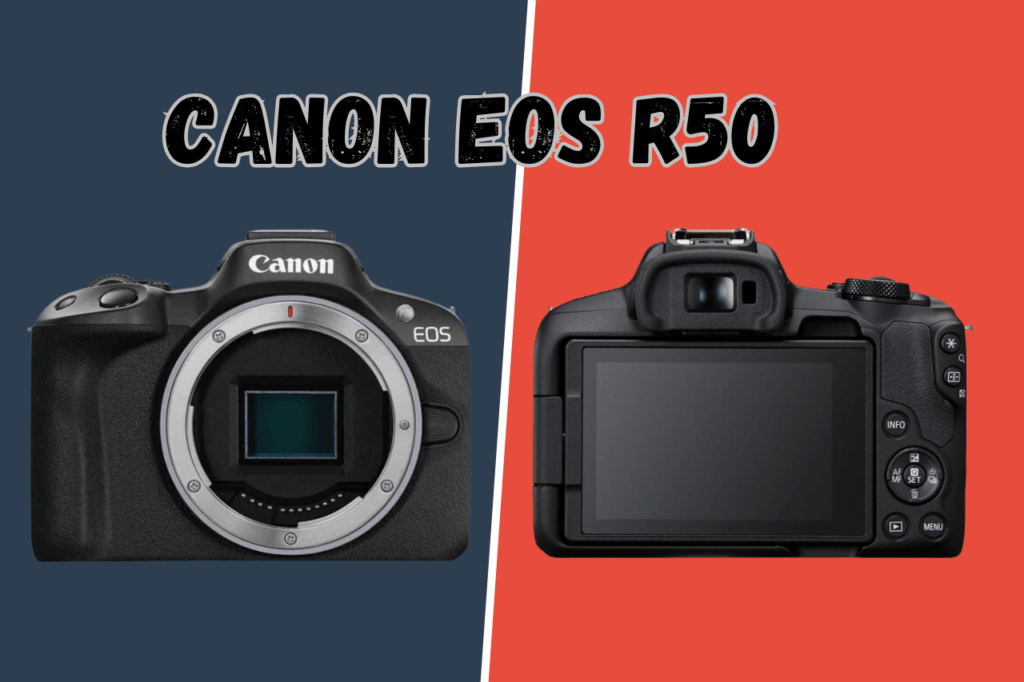
Camera Specifications
- Sensor: 24.2 MP APS‑C CMOS sensor
- Megapixels: Approximately 24.2 MP
- Lens: Canon RF‑S mount (compatible with RF‑S lenses; adapter available for EF/EF‑S lenses)
- LCD: 3‑inch fully articulating touchscreen (around 1.62 million dots)
- Viewfinder: Electronic viewfinder with roughly 2.36 million dots
- Max Continuous Shooting: Up to 15 fps (electronic shutter)
- Max Video Resolution: 4K UHD up to 30 fps
- Targeted Audience: Beginner photographers and content creators
The Canon EOS R50 is designed as an accessible, entry‑level mirrorless camera that makes it easy for beginners and aspiring content creators to step into APS‑C photography. Its 24.2 MP sensor, coupled with Canon’s Dual Pixel CMOS AF system, ensures smooth and accurate focus—even during fast‑action shooting.
This camera is loved because its compact, lightweight design makes it perfect for travel and everyday use. The fully articulating touchscreen and intuitive controls offer a friendly, easy‑to‑use interface, which is ideal for those new to mirrorless systems. Although its 4K video capability is limited to 30 fps, it still delivers quality footage for casual vlogging and social media content. And while it doesn’t offer the advanced features found in higher‑tier models, its overall performance and affordability make it a great starting point for budding photographers.
✔️What I Like:
- Compact and lightweight – perfect travel buddy
- Fully articulating touchscreen – flip, tilt, and tap away
- Reliable Dual Pixel AF – locks on like a pro
- Budget-friendly entry into Canon’s APS-C mirrorless world
- Vibrant image quality that pops
❌What I Don’t Like:
- 4K capped at 30 fps – not ideal for serious videographers
- Viewfinder resolution is… not great
- Missing pro-level features – outgrows you faster than you’d like
- RF-S lens selection is as exciting as a grocery store on a Monday
- Viewfinder is small – squinting may be required
Canon EOS R10

Camera Specifications
- Sensor: 24.2 MP APS‑C CMOS sensor
- Megapixels: Approximately 24.2 MP
- Lens: Canon RF‑S mount (designed for APS‑C; compatible with EF/EF‑S lenses via adapter)
- LCD: 3‑inch fully articulating touchscreen
- Viewfinder: Electronic viewfinder (~2.36 million dots)
- Max Continuous Shooting: Up to 23 fps (electronic shutter) / 15 fps (mechanical shutter)
- Max Video Resolution: 4K UHD up to 60 fps (with crop)
- Targeted Audience: Entry‑level to intermediate photographers and content creators
The Canon EOS R10 packs an impressive performance into a compact body. So, it’s an excellent option for photographers and videographers who want high-speed shooting, without stepping into full‑frame territory. Its high burst rate of up to 23 fps (electronic) ensures you won’t miss those fleeting action moments, which makes it ideal for sports, wildlife, and fast‑paced events.
Price‑wise, the R10 offers a compelling balance between performance and affordability, especially for those who are transitioning from smartphones or entry‑level DSLRs to mirrorless systems.
✔️What I Like:
- Compact and lightweight – perfect for travel and daily adventures
- Snappy 23 fps burst shooting – because life moves fast
- Fully articulating touchscreen – get creative with your angles
- Great image quality with vibrant colors and solid dynamic range
❌What I Don’t Like:
- 4K video is cropped – say goodbye to those ultra-wide shots
- Autofocus is good, but flagship models make it look lazy
- Limited customization – not ideal for control freaks
- No IBIS – better work on that steady hand
Canon EOS R100
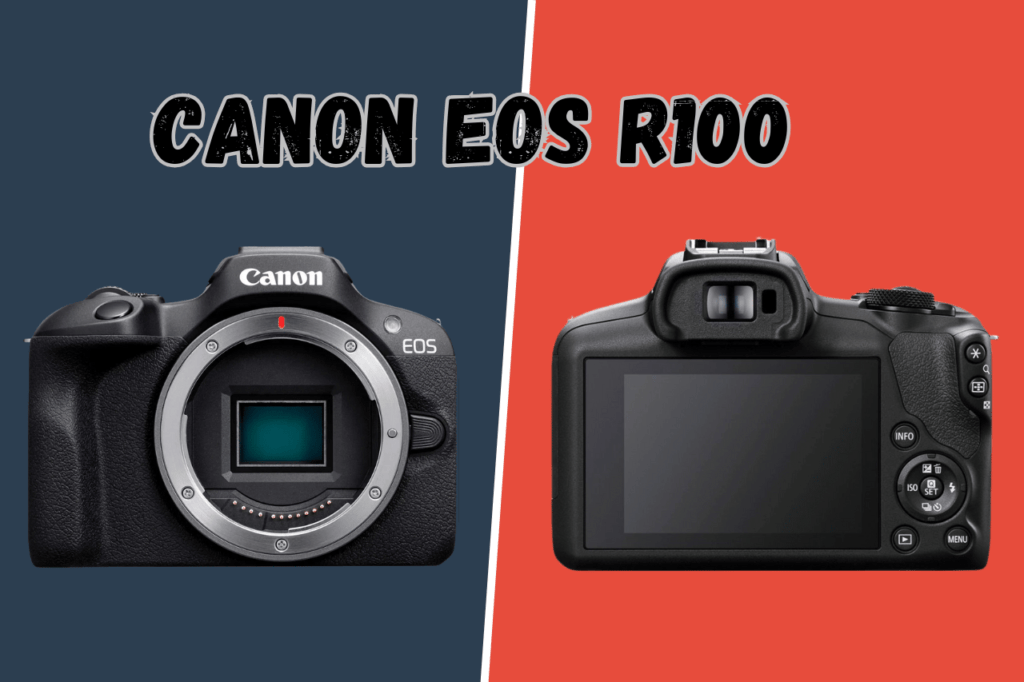
Camera Specifications
- Sensor: 24.1 MP APS‑C CMOS sensor
- Megapixels: Approximately 24.1 MP
- Lens: Canon RF‑S mount (designed for APS‑C lenses)
- LCD: Fixed 3‑inch LCD
- Viewfinder: Basic electronic viewfinder (lower resolution typical of entry‑level models)
- Max Continuous Shooting: Around 6.5 fps (electronic shutter)
- Max Video Resolution: 4K UHD at 24/30p (with crop)
- Targeted Audience: Beginners and casual photographers
The Canon EOS R100 is Canon’s most budget‑friendly entry into the APS‑C mirrorless market. Aimed at newcomers and those who want a simple, cost‑effective solution, the R100 delivers decent image quality with its 24.1 MP sensor. This camera will give you good enough natural colors and a good dynamic range for everyday photography.
Its RF‑S mount opens up access to Canon’s line of APS‑C lenses, while the fixed 3‑inch LCD and basic electronic viewfinder keep things straightforward for users who are just starting out.
But I have to emphasize that the R100 is NOT built for high‑action or professional work; it is just a great learning tool. That’s because of various reasons.
The autofocus system, for example, though reliable in well‑lit conditions, it is basic compared to Canon’s higher‑end models and may struggle with fast‑moving subjects or in low‑light environments.
Its continuous shooting speed of about 6.5 fps is adequate for casual snapshots but might leave action enthusiasts wanting more. Additionally, the 4K video mode, even if it’s capable of recording good footage, it is hampered by a crop factor that limits wide‑angle shooting.
Overall, the EOS R100 offers a good gateway into full‑frame photography on a very tight budget. Sure, you will sacrifice some advanced features found in higher‑tier models, like the DIGIC Accelerator technology, stacked sensor architecture, and advanced autofocus algorithms, but you will get simplicity and affordability. This makes it ideal for beginners who want to learn without a large investment.
✔️What I Like:
- Super budget-friendly – your wallet will thank you
- Compact and lightweight – perfect for beginners on the go
- Decent 24.1 MP sensor for everyday shots
- Simple, no-fuss interface – great for learning the ropes
❌What I Don’t Like:
- Basic autofocus – struggles when the going gets tough
- Slower burst speed – not the best for action shots
- Cropped 4K – say goodbye to wide-angle dreams
- Missing pro-level features – but hey, that’s the trade-off
What About The M Series?

You might notice that all the cameras I talked about belong to Canon’s R series. I agree that models like the M10 or the M50 are decent, but there’s a big reason they didn’t make the list:
Canon officially discontinued the EOS M line in October 2023, meaning no new bodies or native EF-M lenses will be developed. So, there is no point in recommending something for you that you may not find, and even if you do, you will face many problems going forward.
This takes me to the next point. Since there are different cameras, all from the same brand, Canon. You will have to be careful choosing the right mount for lenses.
Now, why does this matter? The lens you use is just as important as the camera itself (if not more important).
Pick the wrong mount, and you’ll be stuck with limited options or forced to rely on adapters. That’s why I wanted to go over Canon’s mounts. So, here’s a quick breakdown:
- RF mount: Used by all the latest Canon mirrorless cameras (both full-frame and APS-C). Full-frame RF lenses also work on smaller APS-C bodies.
- RF-S mount: Designed for Canon’s APS-C mirrorless cameras. It’s the same physical mount as RF, but RF-S lenses are optimized for smaller sensors.
- EF-M mount: Canon’s first-gen APS-C mirrorless mount (EOS M series). It’s discontinued, but you can still find used gear.
- EF mount: The standard mount for Canon DSLRs. EF lenses can be used on RF-mount cameras with an adapter.
- EF-S mount: A variation of the EF mount for APS-C DSLRs. EF lenses work on EF-S cameras but not vice versa. EF-S lenses can also be adapted to mirrorless bodies.
So, if you’re looking for a future-proof setup, I’d suggest you stick with RF or RF-S.
Tips for Choosing the Right Camera
Step 1: Set Your Budget and Investment Goals
Decide how much you’re willing to spend and whether you want a brand-new camera or a cost‑effective refurbished model. This will help narrow down your options right from the start.
Step 2: Define Your Photography Needs
Determine your primary shooting style. Are you into sports, portraits, or landscapes? Once you know your niche, balance the features you need, such as high resolution for detailed landscapes or fast burst rates for sports photography.
Step 3: Future‑Proof Your Choice
Look for a model that supports a strong lens ecosystem and receives regular updates. Choosing a camera with advanced features like improved autofocus or a high‑resolution sensor can ensure that your gear remains relevant as technology evolves.
Step 4: Evaluate Ergonomics and Usability
Test the camera’s comfort, control layout, and build quality. If possible, handle the camera in person or read real user reviews to see how it performs during long shooting sessions.
This way, you would have bought the camera with a clear conscience, knowing that you did what you could to choose the right one for you.
To Sum Up
As you saw, Canon’s mirrorless cameras offer something for every photographer (and videographer). I made sure to choose cameras that not only meet today’s demands but are built for the future. Now, it’s up to you to choose the right camera for you, and go out today to capture amazing shots. But I’d like to remind you once again that, at the end of the day, the camera is just a tool that YOU use to tell your story. So don’t overcomplicate the process of choosing it.
Remember: The best camera is the one you use confidently to tell your story!
